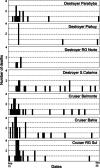Exceptionally high mortality rate of the 1918 influenza pandemic in the Brazilian naval fleet
- PMID: 22336427
- PMCID: PMC5780731
- DOI: 10.1111/j.1750-2659.2012.00341.x
Exceptionally high mortality rate of the 1918 influenza pandemic in the Brazilian naval fleet
Abstract
Background: The naval experience with the 1918 pandemic during World War I remains underexplored despite its key role on the pandemic's global diffusion and the epidemiological interest of isolated and relatively homogeneous populations. The pandemic outbreak in the Brazilian naval fleet is of particular interest both because of its severity and the fact that it was the only Latin American military force deployed to war.
Objectives: To study the mortality patterns of the pandemic in the Brazilian fleet sent to patrol the West African coast in 1918.
Method: We investigated mortality across vessels, ranks, and occupations based on official population and mortality records from the Brazilian Navy Archives.
Results: The outbreak that swept this fleet included the highest influenza mortality rate on any naval ship reported to date. Nearly 10% of the crews died, with death rates reaching 13-14% on two destroyers. While overall mortality was lower for officers, stokers and engineer officers were significantly more likely to die from the pandemic, possibly due to the pulmonary damage from constant exposure to the smoke and coal dust from the boilers.
Conclusions: The fatality patterns observed provide valuable data on the conditions that can exacerbate the impact of a pandemic. While the putative lack of exposure to a first pandemic wave may have played a role in the excessive mortality observed in this fleet, our results indicate that strenuous labor conditions, dehydration, and exposure to coal dust were major risk factors. The unequal death rates among vessels remain an open question.
© 2012 Blackwell Publishing Ltd.
Figures





Similar articles
-
We could learn much more from 1918 pandemic-the (mis)fortune of research relying on original death certificates.Ann Epidemiol. 2018 May;28(5):289-292. doi: 10.1016/j.annepidem.2018.01.002. Epub 2018 Jan 9. Ann Epidemiol. 2018. PMID: 29352631 Free PMC article.
-
Spatiotemporal patterns of pandemic influenza-related deaths in Allied naval forces during 1918.Epidemiol Infect. 2013 Oct;141(10):2205-12. doi: 10.1017/S0950268812003032. Epub 2013 Jan 16. Epidemiol Infect. 2013. PMID: 23324307 Free PMC article.
-
Pandemic influenza outbreak on a troop ship--diary of a soldier in 1918.Emerg Infect Dis. 2012 Nov;18(11):1900-3. doi: 10.3201/eid1811.AD1811. Emerg Infect Dis. 2012. PMID: 23092739 Free PMC article.
-
Death from 1918 pandemic influenza during the First World War: a perspective from personal and anecdotal evidence.Influenza Other Respir Viruses. 2014 Sep;8(5):538-46. doi: 10.1111/irv.12267. Epub 2014 Jun 27. Influenza Other Respir Viruses. 2014. PMID: 24975798 Free PMC article. Review.
-
The unusually diverse mortality patterns in the Pacific region during the 1918-21 influenza pandemic: reflections at the pandemic's centenary.Lancet Infect Dis. 2018 Oct;18(10):e323-e332. doi: 10.1016/S1473-3099(18)30178-6. Epub 2018 May 10. Lancet Infect Dis. 2018. PMID: 29754745 Review.
Cited by
-
Loose Ends in the Epidemiology of the 1918 Pandemic: Explaining the Extreme Mortality Risk in Young Adults.Am J Epidemiol. 2018 Dec 1;187(12):2503-2510. doi: 10.1093/aje/kwy148. Am J Epidemiol. 2018. PMID: 30192906 Free PMC article.
-
Extreme Overcrowding and Extreme Lethality During the 1918 Influenza Pandemic.Am J Public Health. 2022 Oct;112(10):1372-1373. doi: 10.2105/AJPH.2022.307060. Epub 2022 Aug 25. Am J Public Health. 2022. PMID: 36007203 Free PMC article. No abstract available.
-
We could learn much more from 1918 pandemic-the (mis)fortune of research relying on original death certificates.Ann Epidemiol. 2018 May;28(5):289-292. doi: 10.1016/j.annepidem.2018.01.002. Epub 2018 Jan 9. Ann Epidemiol. 2018. PMID: 29352631 Free PMC article.
References
-
- Crosby A. America’s Forgotten Pandemic. Cambridge, UK: Cambridge University Press, 1989.
-
- Patterson K, Pyle G. The geography and mortality of the 1918 influenza pandemic. Bull Hist Med 1991; 65:4–21. - PubMed
-
- Johnson N, Mueller J. Updating the accounts: global mortality of the 1918–1920 “Spanish” Influenza pandemic. Bull Hist Med 2002; 76:105–115. - PubMed
Publication types
MeSH terms
LinkOut - more resources
Full Text Sources
Medical

